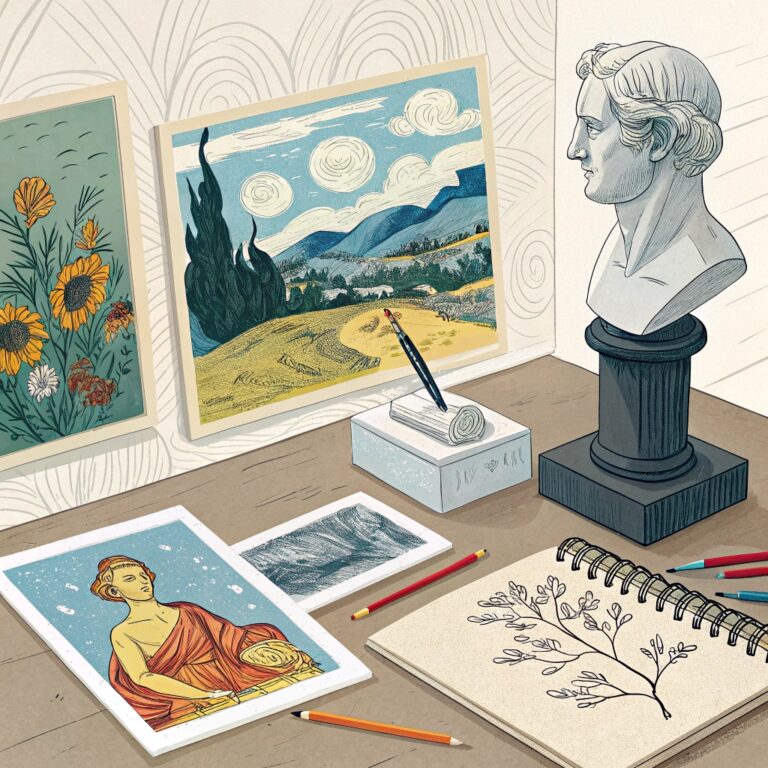
The Art genre is a celebration of creativity in all its forms. It invites readers to see, feel, and think differently—whether through a brushstroke, a sculpture, a photograph, or a bold design. These books explore the processes behind visual expression, the stories behind iconic works, and the role art plays in shaping culture, identity, and emotion.
Art books don’t just showcase beauty—they challenge perception, celebrate innovation, and often ask deeper questions about meaning, purpose, and society. Whether you’re flipping through a coffee table book filled with masterpieces or diving into an artist’s personal journey, the Art genre opens your eyes to what it means to create—and to be moved by creation.
This genre often explores:
Art History & Movements: From the Renaissance to Dadaism, exploring the context, impact, and evolution of visual styles.
Artist Biographies & Memoirs: Intimate portraits of creative minds, revealing the inspiration and struggle behind their work.
Art Instruction & Technique: Practical guides for drawing, painting, photography, digital art, and more.
Design, Illustration, and Visual Communication: Exploring how visual elements convey ideas across mediums and industries.
Philosophy & Criticism of Art: Thoughtful essays on aesthetics, interpretation, and the role of art in society.
Whether academic, practical, or purely visual, the Art genre is where thought meets form—and where imagination finds a home.
Writing in the Art genre means bringing your reader into the creative process, whether you’re analyzing a painting, breaking down technique, or sharing the story of a visionary. Here’s how to craft a book that captures the essence of art:
Choose Your Focus and Format
Are you creating a how-to guide, a visual anthology, a biography, or a critical essay? Art books range from image-driven to text-heavy, so define your purpose and audience early.
Balance Visuals With Insight
High-quality visuals are essential—but context matters too. Explain techniques, symbolism, influence, or history to enrich the viewer’s understanding.
Tell the Story Behind the Work
Whether about a piece, a movement, or an artist’s evolution, storytelling is key. Bring emotion, struggle, and intention into the spotlight.
Simplify the Complex Without Dumbing It Down
If you’re discussing art theory, composition, or color science, make the information accessible without sacrificing depth. Analogies and real-world examples help.
Let Passion Lead the Way
Art is deeply personal. Write with the same passion you’d bring to a canvas or gallery—your enthusiasm should infuse every page.
Include Step-by-Step Visuals for Instructional Content
For how-to books, visuals should match every major step or concept. Diagrams, progress photos, and finished examples guide the reader’s hand and eye.
Honor Diversity and Global Perspectives
Great art books reflect the full spectrum of human creativity. Be inclusive of different cultures, techniques, and artistic voices.
These essential titles have inspired artists, thinkers, and lovers of beauty across generations:
Ways of Seeing by John Berger
Did you know? This groundbreaking book—and TV series—changed the way people think about visual culture, art history, and the male gaze.
Steal Like an Artist by Austin Kleon
Did you know? This small, powerful guide teaches that creativity is about remixing, borrowing, and transforming—not creating in a vacuum.
The Story of Art by E.H. Gombrich
Did you know? A global bestseller for over 70 years, this accessible art history guide takes readers from prehistoric cave paintings to modernism.
Just Kids by Patti Smith
Did you know? This memoir captures the raw, artistic spirit of 1970s New York through the lens of musician and poet Patti Smith’s relationship with photographer Robert Mapplethorpe.
The Artist’s Way by Julia Cameron
Did you know? More than a workbook, this spiritual guide has helped millions overcome creative blocks and rediscover their inner artist.
Explores significant periods, styles, and schools of art across cultures and time.
Example: The Shock of the New by Robert Hughes
Step-by-step guides for mastering drawing, painting, sculpture, and digital tools.
Example: Drawing on the Right Side of the Brain by Betty Edwards
Tells the stories behind great creators—their struggles, successes, and evolution.
Example: Van Gogh: The Life by Steven Naifeh and Gregory White Smith
Collections that tell stories through images, sometimes with minimal text.
Example: Humans of New York by Brandon Stanton
Analyzes art through cultural, political, and philosophical lenses.
Example: What Is Art? by Leo Tolstoy
Ready to share your story?
Tell us what you need—we’ll help bring your book to life.
